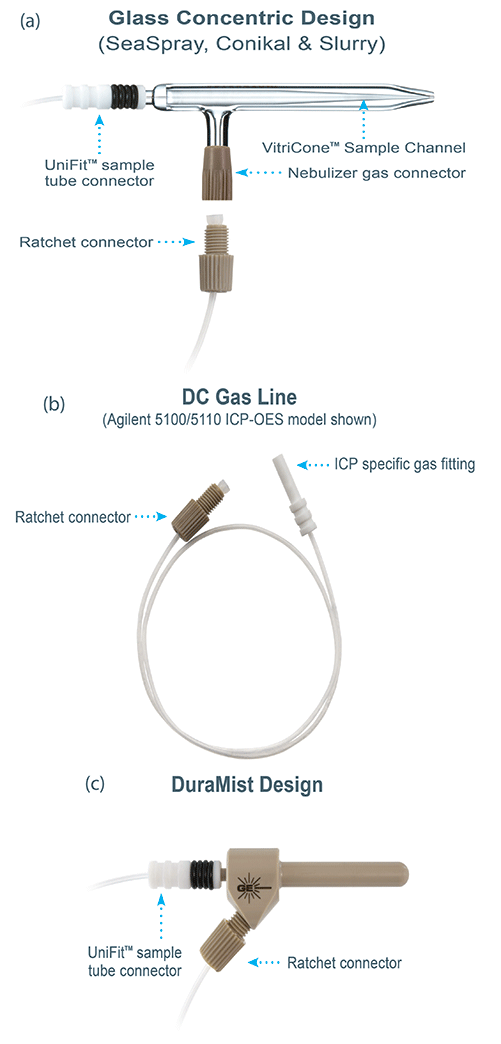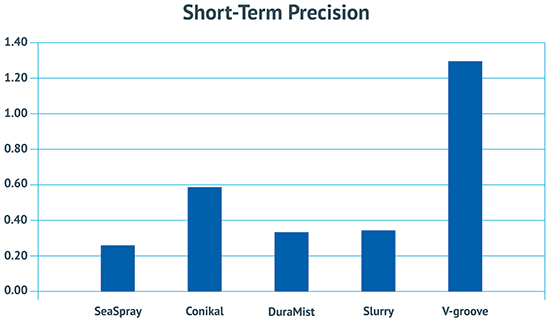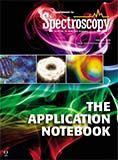High-Performance ICP-OES Sample Introduction: How to Choose and Use the Best Nebulizer for Your Analysis
Special Issues
In this study, we compare the performance of Glass Expansion’s most popular concentric nebulizer designs for ICP-OES applications, as well as a parallel-path nebulizer from another vendor, providing a complete selection guide based on performance and design.
Nebulizer selection is a critical but often overlooked aspect of ICP-OES analyses. There are many different nebulizers available for ICP-OES, and choosing the optimal one can be confusing and difficult. To achieve peak performance from your ICP, it is essential to choose the proper nebulizer based on your sample types, in addition to any necessary accessories to maintain long-term performance. In this study, we compare the performance of Glass Expansion's most popular concentric nebulizer designs for ICP-OES applications, as well as a parallel-path nebulizer from another vendor, providing a complete selection guide based on performance and design.
Nebulizer selection is challenging because there are many different types available: concentric, parallel-path, and cross-flow, to name a few. By far, concentric nebulizers are the most common type found on instruments today, as they generally provide the best performance. Even within the narrower category of concentric nebulizers, there is quite a range of designs. Glass Expansion offers the largest range by any manufacturer, each model having a variety of applications for which it is ideally suited (1).
It is important to note that all concentric glass nebulizers are not the same. Glass Expansion's designs feature a unique VitriCone™ sample capillary (Figure 1a), which is machined (as opposed to heated and drawn) from a thick-walled capillary, resulting in a highly reproducible geometry and consistent internal diameter (ID). Since the thickness is not compromised, the capillary resists harmonic vibration caused by the high-velocity argon flow, giving the best short-term precision. Non-Glass Expansion designs typically use a hand-drawn sample capillary, resulting in an ID that varies over the length, preventing a laminar flow and creating points where particulates can lodge, as well as being fragile and susceptive to harmonic vibrations.
Glass Expansion nebulizers also feature a Direct Connection (DC) gas line, as seen in Figure 1b, which features a ratchet fitting on one end, and an instrument-specific gas fitting on the other. The ratchet fitting provides a reliable, leak-free gas connection to the nebulizer, maintaining optimal backpressure for consistent performance.
The SeaSpray™ nebulizer is a glass concentric nebulizer that features a self-washing tip with smooth surfaces to avoid build-up of salt crystals. It provides outstanding nebulization efficiency and excellent tolerance up to 20% dissolved solids, without compromising detection limits.
The Conikal™ glass concentric nebulizer is a high-precision nebulizer for routine analysis of aqueous and organic samples.
The HF-resistant DuraMist™ concentric nebulizer (Figure 1c) is manufactured from inert PEEK materials. It offers high sensitivity, with excellent short-term precision and the highest tolerance to TDS of any concentric nebulizer. It is a great "all-rounder" and the choice for analysis of diverse sample types.

Figure 1: Glass Expansion concentric nebulizer design features.
The Slurry™ glass concentric nebulizer is designed for analysis of slurries, suspensions, and wear metals. It provides the excellent sensitivity and short-term precision of a glass concentric nebulizer, and it is tolerant to particulates up to 150 μm in diameter.
Parallel-path (or v-groove) nebulizers vary greatly in cost and performance. The large-bore capillary is designed to resist blockages, but this results in larger droplets and a wider drop size distribution, affecting both efficiency and precision. Parallel-path designs also typically suffer from poorer reproducibility in performance from one nebulizer to the next.
Results
In this study, we compared the performance of the SeaSpray, Conikal, DuraMist, Slurry, and a non-Glass Expansion parallel-path design. Some of the criteria that need to be considered when selecting a nebulizer for ICP-OES applications are listed below:
- Tolerance to TDS
- Tolerance to particulates
- Tolerance to HF
- Precision (RSD)
- Sensitivity (SRBR)
Short-term analytical precision (%RSD) is one of the most critical figures of merit for ICP-OES applications. With RSDs, the lower the figure, the better, as this represents less variability in the analytical signal. In Figure 2, the SeaSpray nebulizer shows the best short-term precision of 0.26% RSD, whereas the parallel-path nebulizer gives the worst precision at 1.3% RSD. Due to the design of the parallel-path nebulizer, precision can be improved at higher sample flow rates (1.5–2 mL/min). However, higher sample flow rates are not desirable in many ICP applications, due to plasma stability issues, limited sample volumes, or autosampler capacity.

Figure 2: Comparison of short-term analytical precision of 5 ppm Mn at 0.7 mL/min sample uptake.
With a solid-state detector, the most reliable figure of merit for detection limits is the signal-to-root background ratio (SRBR), as measuring detection limits with multiple solutions and a large number of replicates is both slow and prone to significant statistical variation. With SRBR, the higher the value, the lower the limit of detection. In Figure 3, the SeaSpray offers the highest SRBR value (indicating the lowest detection limits), with the DuraMist giving the next best results. The Slurry and Conikal are similar and followed closely behind, with the parallel-path offering the lowest SRBR values (and worst detection limits) of the nebulizers examined.

Figure 3: Comparison of SRBR at 0.7 L/min nebulizer gas flow.
In order to maximize the lifetime of these performance benefits, it is important to select accessories that will mitigate the effects of certain sample types. For high-TDS samples, pairing the SeaSpray or DuraMist with the Elegra argon humidifier will help maintain analytical performance (2). Humidifying the nebulizer gas helps to alleviate salt deposits in the nebulizer and torch injector, allowing uninterrupted and maintenance-free operation. In order to prevent any issues with clogs or blockages due to particulates, the Guardian in-line particle filter can be installed to eliminate the risk of particulates getting trapped in the nebulizer or capillary tubing (3).
Lastly, to keep your nebulizer in good condition, always follow the manufacturer-recommended maintenance procedure, and do not use wires or sonicating baths. Glass Expansion's Eluo Nebulizer Cleaning Tool provides a safe and convenient way to remove blockages (3).
Conclusion
If you want the best performance your ICP-OES can provide, it is essential that you choose the proper nebulizer to meet the demands of your sample types, in addition to following recommended maintenance procedures to ensure consistent performance and long life. In this application note, we presented a selection guide based on several performance criteria. However, if you require any further assistance selecting a sample introduction system, please contact us at enquiries@geicp.com or visit www.geicp.com.
References
(1) Glass Expansion June 2013 Newsletter, A Nebulizer Update.
(2) Glass Expansion Newsletter, February 2016, The Elegra Argon Humidifier: Uninterrupted and Maintenance-Free ICP Operation
(3) Glass Expansion Newsletter, June 2017, Considerations when Analyzing Real-World Samples by ICP Spectrometry

Glass Expansion, Inc.
31 Jonathan Bourne Dr., Unit # 7, Pocasset, MA 02559
tel. (508) 563-1800, fax (508) 563-1802
Website: www.geicp.com

LIBS Illuminates the Hidden Health Risks of Indoor Welding and Soldering
April 23rd 2025A new dual-spectroscopy approach reveals real-time pollution threats in indoor workspaces. Chinese researchers have pioneered the use of laser-induced breakdown spectroscopy (LIBS) and aerosol mass spectrometry to uncover and monitor harmful heavy metal and dust emissions from soldering and welding in real-time. These complementary tools offer a fast, accurate means to evaluate air quality threats in industrial and indoor environments—where people spend most of their time.
NIR Spectroscopy Explored as Sustainable Approach to Detecting Bovine Mastitis
April 23rd 2025A new study published in Applied Food Research demonstrates that near-infrared spectroscopy (NIRS) can effectively detect subclinical bovine mastitis in milk, offering a fast, non-invasive method to guide targeted antibiotic treatment and support sustainable dairy practices.
Smarter Sensors, Cleaner Earth Using AI and IoT for Pollution Monitoring
April 22nd 2025A global research team has detailed how smart sensors, artificial intelligence (AI), machine learning, and Internet of Things (IoT) technologies are transforming the detection and management of environmental pollutants. Their comprehensive review highlights how spectroscopy and sensor networks are now key tools in real-time pollution tracking.